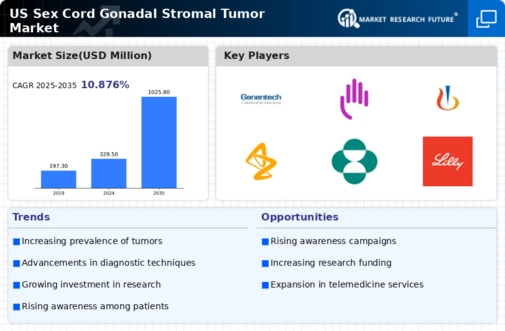Increased Research Funding
The allocation of increased research funding for rare tumors is a crucial driver for the sex cord-gonadal-stromal-tumor market. Government and private institutions are recognizing the need for more comprehensive studies to understand these tumors better. In recent years, funding for cancer research in the US has seen a rise, with the National Cancer Institute allocating millions of dollars specifically for rare tumor research. This influx of funding is expected to facilitate the development of new therapies and diagnostic tools, thereby enhancing the overall market landscape for sex cord-gonadal-stromal tumors.
Growing Awareness of Rare Tumors
The increasing awareness surrounding rare tumors, including sex cord-gonadal-stromal tumors, is driving the market forward. Educational initiatives by healthcare organizations and advocacy groups are enhancing knowledge among both healthcare professionals and patients. This heightened awareness is likely to lead to earlier diagnosis and treatment, which could improve patient outcomes. In the US, the incidence of sex cord-gonadal-stromal tumors is estimated to be around 1 in 100,000 individuals, indicating a niche yet significant patient population. As awareness grows, the sex cord-gonadal-stromal-tumor market is expected to expand, with more resources allocated to research and treatment options.
Rising Incidence of Hormonal Disorders
The rising incidence of hormonal disorders is contributing to the growth of the sex cord-gonadal-stromal-tumor market. Conditions such as polycystic ovary syndrome (PCOS) and other endocrine disorders can lead to an increased risk of developing sex cord-gonadal-stromal tumors. As awareness of these hormonal issues grows, more patients are seeking medical advice, leading to higher diagnosis rates. This trend is likely to create a larger patient base for the sex cord-gonadal-stromal-tumor market, as healthcare providers focus on early detection and management of related conditions.
Technological Innovations in Treatment
Technological advancements in treatment modalities are significantly impacting the sex cord-gonadal-stromal-tumor market. Innovations such as minimally invasive surgical techniques and improved imaging technologies are enhancing treatment efficacy and patient recovery times. For instance, laparoscopic surgery has become a preferred method for tumor removal, reducing hospital stays and associated costs. The market is projected to witness a growth rate of approximately 5% annually, driven by these technological improvements. As new treatment technologies emerge, they are likely to attract investment and research funding, further propelling the sex cord-gonadal-stromal-tumor market.
Collaboration Among Healthcare Providers
Collaboration among healthcare providers is emerging as a vital driver for the sex cord-gonadal-stromal-tumor market. Multidisciplinary teams, including oncologists, endocrinologists, and pathologists, are increasingly working together to provide comprehensive care for patients. This collaborative approach not only enhances treatment outcomes but also fosters the sharing of knowledge and resources. As healthcare systems in the US continue to emphasize integrated care, the sex cord-gonadal-stromal-tumor market is likely to benefit from improved patient management strategies. Increased referrals for specialized treatment will also contribute..
























Leave a Comment